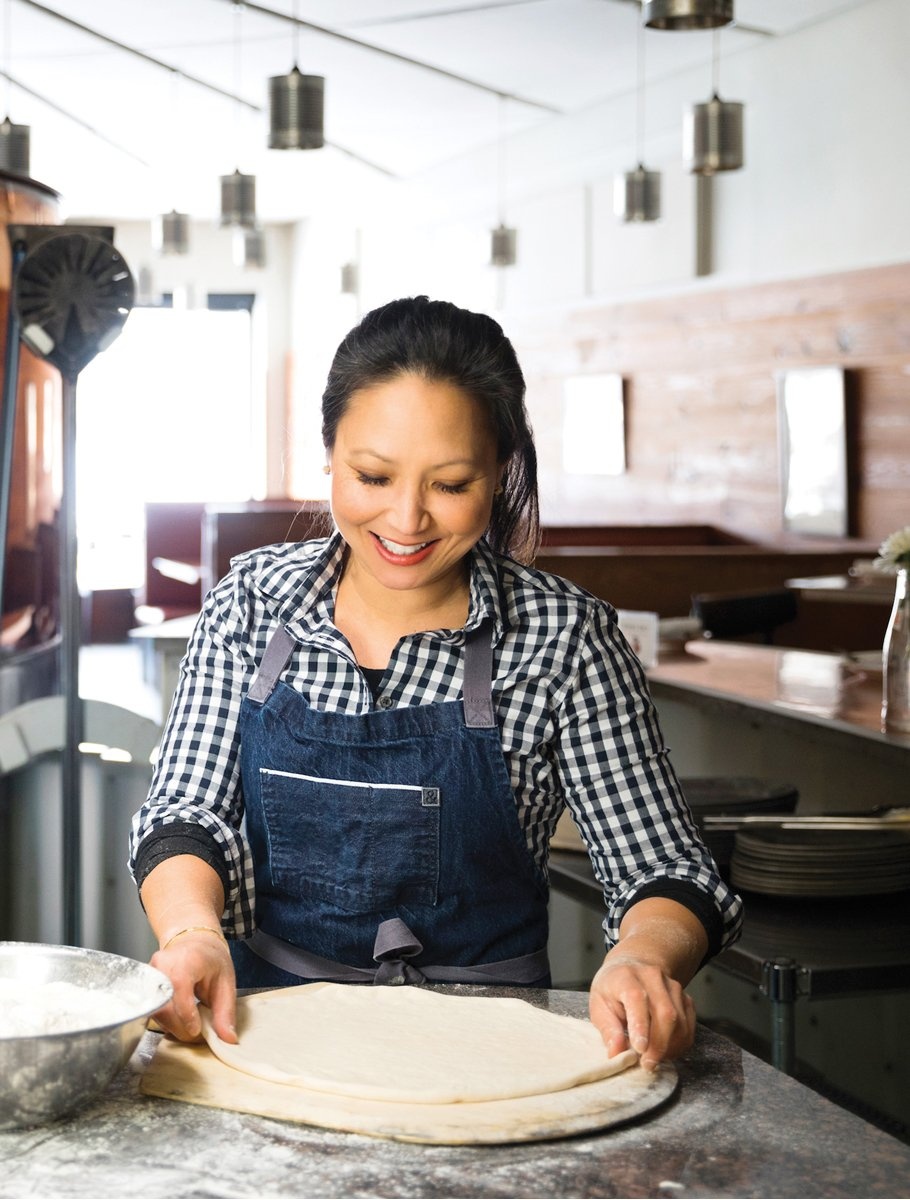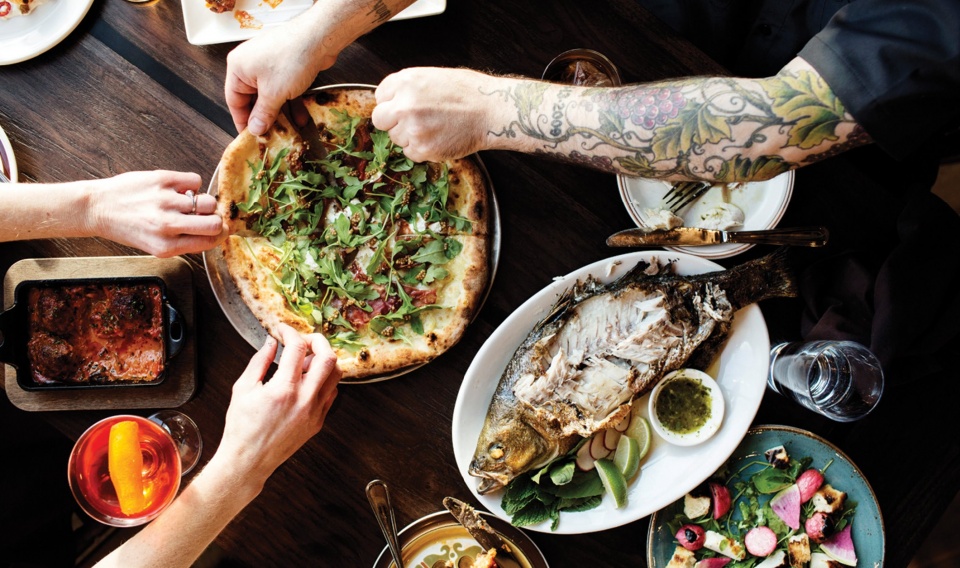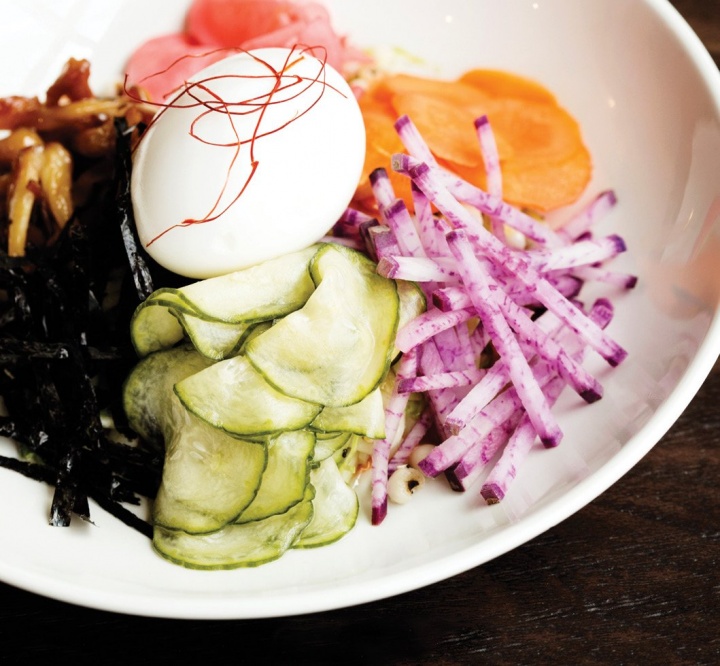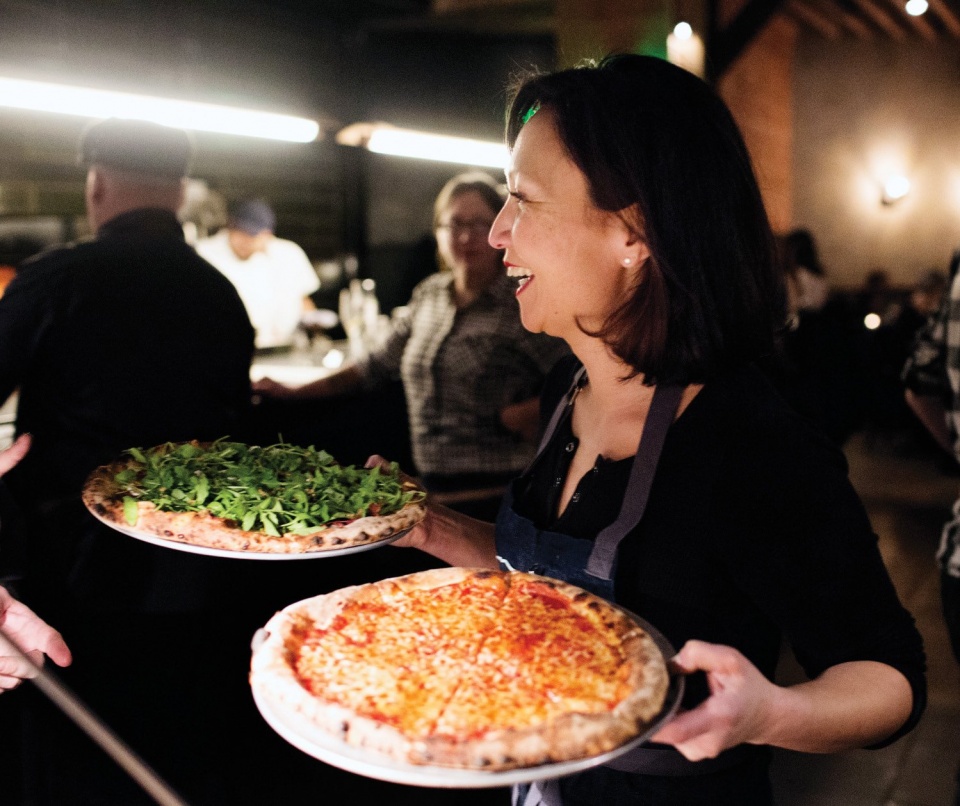James Beard Award winner Ann Kim ’95
is bringing the heat to the Twin Cities.
Columbia College | Columbia University in the City of New York
James Beard Award winner Ann Kim ’95
is bringing the heat to the Twin Cities.

Kim at the oven at Pizzeria Lola.
SPACECRAFTING
Over the past decade, the elemental hiss and crackle has fueled the Minneapolis chef’s rise to national prominence and, earlier this year, a James Beard Award as best chef in the Midwest. It’s the essential ingredient at two of her three Twin Cities restaurants: At her hand, it will make you rethink a dish as simple as roasted cauliflower and go downright swoony over a charred yet somehow still chewy pizza crust. A wood-fired oven stands literally at the center of Kim’s first shop, Pizzeria Lola; its gleaming copper back appears to arriving diners more like a Richard Serra sculpture. Only after rounding a bend to sit at the bar does the open mouth reveal the flame.
“Cooking by fire, to me, is a craft,” Kim told me back in July; we were sitting in a booth at Lola, just feet from the shiny hull. “It’s something that you can’t teach via textbook. It’s a physical, visceral something that you feel in your body.
“We burned a lot of pizzas,” Kim added. “We made a lot of shitty pizza before we made good pizza in this oven. We learned. And we evolved.”
Part of the evolution was remaking the dough recipe she’d exactingly developed in her home kitchen. “How that recipe would react and cook in a home oven that got up to 500 degrees max is very different than what happens when you get up to 900 degrees-plus. It was back to the drawing board, testing, until I found the crust that I really wanted to make.”
That was in 2010, and after opening a slice shop, Hello Pizza, as her sophomore venture, Kim returned to the fiery theme in November 2016, with Young Joni. The inventive pizzas-and-more menu leaned into her Korean heritage and relied on the alchemy created by cooking in that same style of wood-fired oven (two, in fact) and over a wood-burning grill. Young Joni was named the Star Tribune 2017 Restaurant of the Year, one of GQ’s Best New Restaurants in America and one of Travel & Leisure’s leading reasons for food lovers to visit the Twin Cities. (Plus it’s Vikings receiver Stefon Diggs’s favorite restaurant — no small endorsement in the city of the Minneapolis Miracle.) Young Joni’s success also cemented Kim’s role in what’s been widely touted as a regional dining revolution.
“It’s really about understanding fire and how to manipulate it,” Kim said. “It’s not autopilot — we’re not going to turn up the convection oven and just go. You have to focus, pay attention, be patient. And you have to practice. Sometimes the fire is going to have its own mind and you have to work around that. But that to me is exciting.”
My lunch with Kim had been in the works for months — nearly moved so she could attend an invitation-only, wood-fire cooking event in Ireland, then back on again. Arriving early, I took time to drive the neighborhood, technically the outskirts of Minneapolis, where the city meets the friendly suburb of Edina. But “neighborhood” was the word for it. The side streets were primarily residential, and even the main road that Pizzeria Lola fronts was house-lined and sleepy; another 10 minutes passed before I reached a typical small-town cluster of retail, coffee shops and eateries. Kim later told me that her and her husband Conrad Leifur’s first home was less than a mile away. “We were walking our dog and we saw a for-lease sign. It used to be a local convenience store; we said, ‘This is it.’”
“As a chef, I’ve found my calling and this is my expression.
This is my best self.”
Location, as I came to learn, was an essential part of Kim’s vision. When dreaming about what she wanted in a place of her own, she thought back to her College days: “One thing I really missed in Minneapolis was pizza — and the other was a restaurant that felt like home. Because being in New York, you could go to any corner and there was always a small little neighborhood joint. Here, it was lots of chains. I wanted a place where I’d love my surroundings, love the people that I worked with and could get to know my guests as family.”

THE RESTAURANT PROJECT
Walking in the door at Lola (named, incidentally, for Kim’s sweet-faced Weimaraner), I certainly felt the warmth of a small-town spot. The decor was simple and cheerful, lots of wood and recycled light fixtures. A back-lit, black-lettered specials sign had the look of something pulled from a roadside ice cream stand. Strips of smiling and goofy faces, taken in the restaurant’s photo booth, lined a side wall.
Kim arrived a few minutes after me — voice bright, with a hint of Minnesota accent — and ordered up a heap of food: the aforementioned cauliflower, a matchstick zucchini special and meatballs that on another day could have been the main event. There were also two dizzyingly good pizzas: the Xerxes (a Greek-y pizza with feta, sautéed spinach and Marcona almonds) and the Korean BBQ (beef short ribs, scallions, soy-chili vinaigrette). The latter is their bestseller, a one-week special that was brought back for good after bummed-out customers kept calling to complain.
As we talked, I found Kim to be exuberant, sincere, uncensored. I was reminded that this is the woman who several years ago went viral with a tweet declaring, “Fuck fear, lesson learned” — a reference to how she’d nearly launched her career with the “safe choice” of franchising a Jimmy John’s sandwich shop. This is also the woman who opened her James Beard acceptance speech by tearily admitting that she’d just come back from the restroom, where she’d taken off her Spanx.
In fact, Kim seems so comfortable with who she is that it’s hard to imagine that her younger self struggled with expectations that she’d pursue a different path — one that ended in a job with letters after it, “you know, Ph.D., M.D., J.D.” She characterizes hers as “a stereotypical immigrant story — the family moves here, they want their children to have a better life.” But the particulars of her experience are quick to emerge: Her family came to Apple Valley, Minn., from Korea when Kim was 4. They didn’t have a lot of money; her father had been an accountant before the move, but here worked in a bottle factory and, later, for the post office; her mother (the “Young” of Young Joni) was a housekeeper in a nursing home.

The Bibim Grain salad from Young Joni.
THE RESTAURANT PROJECT
By her own account, Kim was always a creative person, but felt repressed growing up; she was drawn to Columbia by the Core Curriculum and because it was the kind of good school her parents wanted her to attend. But New York also spoke to her secret ambition to be an actress. After graduation, she briefly dabbled in law firm jobs before returning to Minnesota, where she could manage the cost of living while wading into the theater scene. As soon as she was cast in a full-time acting gig, she quit her job with the general counsel of a small company. Her parents found out only after calling there one day to speak with her.
“They were really disappointed; they sort of disowned me for a period of time. They really thought that I was destroying my life, that there was no future in it.” She again kept it to herself when she set her sights on becoming a chef.
Today, Kim says, that’s all far in the past. Her parents now do drive-bys to see if her restaurants are busy. “I was always fighting who I really was,” Kim muses, “what my soul really felt, versus what I felt like I had to do and had to be. And now, as a chef, I’ve found my calling and this is my expression. This is my best self.”
Growing up in Minnesota in the 1970s, Kim recalls, there wasn’t a lot of diversity in the food at the grocery store. What couldn’t be bought had to be made by her mother and maternal grandmother. At a young age, Kim was helping to make kimchi (they brined cabbage in the family kiddie pool to make batches large enough to last the winter). In the summer, she tended a garden planted with Korean vegetable seeds that her mother had smuggled in. While Kim never dreamed of becoming a chef per se, she always loved to entertain and have people over. “I’m such an active go-go-go person, but when we cook together and gather people and slow down, it always gave me a lot of peace and satisfaction.”
Cut to 2009. It was the recession, and Leifur had recently lost his job in finance; she was unhappy and looking for more agency in her work than acting allowed. “We said, let’s do something that feeds us emotionally, where we wake up and we’re grateful,” Kim recalled. “Conrad’s the one who said, ‘You’re an amazing cook. Why don’t we open a restaurant?’”
Then came the near-contract to open a Jimmy John’s, and their decision to take the leap to open the pizza place of their dreams. Kim spent countless hours in her home kitchen developing her ideal crust — for her, the key to a great pie. She did a deep dive into artisan bread-making books, visited crust-obsessed corners of the internet and kept records of every trial, noting the relative humidity and outside temperature, and how it reacted with her dough. (Kim is by her own admission a recovering perfectionist.)
Kim designed what she calls “a neo-Neapolitan pie,” with a crust that combined attributes of her holy trinity: Neapolitan (soft and bubbly), classic New York (foldable yet crispy) and New Haven-style (charred and coal-fired).
When Kim realized she’d need professional help, she enrolled in an intensive course at Tony Gemignani’s International School of Pizza, in San Francisco. (“I didn’t know it at the time, but if you want to learn about every style of pizza, he is kind of the man,” Kim says.) That’s where she fell in love with fire, and returned for several apprenticeships. “There was a lot of R&D,” says Gemignani. “Ann was very particular; she would drill me. She knew what she wanted, and when we’d try something she’d say — ‘nah, it’s too soft, it’s too wet, that’s not it.’ It wasn’t easy. But sometimes the best students are the ones who are trying to achieve greatness.” Ultimately, Kim designed what she calls “a neo-Neapolitan pie,” with a crust that combined attributes of her holy trinity: Neapolitan (soft and bubbly), classic New York (foldable yet crispy) and New Haven-style (charred and coal-fired).
When Pizzeria Lola opened in late 2010, Kim was kneading all of the dough herself; she devised a menu that was simple, seasonal and pizza-focused. In a last-minute twist, she experimented with Korean flavors — thus was born the kimchi-topped Lady ZaZa. It was a natural combination for Kim, who’d added the fermented favorite to pizza (and every other meal) as a kid. For customers, it was a radical departure. “A lot of people said, ‘We don’t know what kimchi is,’ and I always replied, ‘If you don’t like it you don’t have to pay for it, but give it a go if you’re curious.’ I kind of chuckle to think that a lot of customers’ first exposure to kimchi is on our pizza, but if that expands their horizons and makes them want to explore Korean cuisine, or other cuisines they’re unfamiliar with, then hey, that’s awesome.”

PIZZERIA LOLA
Early success for Lola came from word of mouth. Then, in 2012, Diners, Drive-Ins and Dives came calling. “The first question I asked was, ‘Do we have to close?’” Kim says with a laugh. “All I could think was, we need butts in seats, we need to pay this restaurant off.” Knowing when the episode would air, they timed a change in their schedule and offered lunch for the first time the next day. “Thirty minutes before we opened, we had a line out the door,” Kim recalls. “It was nonstop, just packed, until we closed. It was bonkers.”
Looking back, Kim says they turned inexperience into an asset: “We were open to any sort of possibility because we didn’t know that you ‘shouldn’t do that.’” But since then she has also learned: “If your intention is there and you listen to your gut, it usually turns out right.”
Back at Lola, shortly before our pizzas arrived, a couple stopped by the table to introduce themselves — “We saw you and couldn’t help ourselves,” the woman said. She asked about the “epic dinner” Kim had posted on Instagram the night before, and Kim easily fell into a few minutes of chat (as it happened, the dinner was a home-grilled affair by friend and fellow James Beard winner Alex Roberts, to celebrate Kim’s award). “We’re such fans,” the woman said by way of goodbye. “We love everything you do.”

Kim in her happy place, serving customers at Young Joni.
THE RESTAURANT PROJECT
“Everything,” at this stage, includes three restaurants; a fourth is on the way. Kim leads the culinary side of the house while Leifur is CFO (they founded parent company Vestalia Hospitality in 2015). “I love the act of inspiration, creating things and coming up with ideas and places where people can gather,” Kim said. “If there’s something missing — if I say, ‘I wish this existed here’ — then something starts to bubble up. ‘Is anyone doing this? Why isn’t anyone doing this? We should have this.’”
She walked me through some of her a-ha moments: an old hardware store struck her as the place for a classic New York slice joint — what became the playful Hello Pizza in 2013. (The vibe was evident even under construction, thanks to the giant Lionel Richie banner in the window.) Young Joni came from a visit to Northeast Minneapolis, an up-and-coming, artist-driven part of the city. Kim envisioned a neighborhood restaurant like Lola, “but one that was a little different, a little more sophisticated, a little sexier.” The result was a handsome, wood-beamed space that conjures what master food writer Adam Sachs termed a “Korean-Midwestern hygge”; Kim has said that she wants diners to feel like they’re getting wrapped in a bear hug.
Kim gets atmosphere, according to Star Tribune restaurant critic Rick Nelson. “I think that comes from being in the theater,” he says. “Her places aren’t showy, but they feel special. She also gets hospitality in a way that I think a lot of people here don’t.”
He noted that at Young Joni, a lot of the seats are around counters or large communal tables that encourage sharing and conversation. “Minnesotans are a very stand-offish kind of people,” Nelson, a lifelong resident, says with a laugh. “We’re polite, but we’re very particular about personal space. At Young Joni alone, Ann has taught people, it’s really fun to go out and sit next to a stranger and get to know them and talk about food and drink and the city and world.”
In the bigger picture, Kim is in fact contributing to an evolution in Twin Cities dining culture. It goes beyond cultivating a more social experience; it’s also an expansion of tastes. What many think of as traditional Minnesota fare — hotdish and tater tots, or Scandinavian fare like lutefisk or lefse — is no longer the dominant mode. Kim credits the change in part to a diversifying population: “People are looking for food that not only challenges them but is also just good. It’s no longer about saying this is ‘ethnic cuisine.’ It’s just, this is the food that represents who we are as a community, now, in this present time.”
The meat-and-potatoes DNA still exists here, says Nelson, who has a long view after more than 25 years in the business. “But the dining public is way more adventurous than it used to be, and people are willing to spend money in ways they didn’t before.” Kim was among the chefs he cited in a recent, sweeping overview that declared the Twin Cities’ ascension to a three-star — “highly recommended” — town. “In the last seven or eight years there has been enormous growth in the number of exceptional and interesting and diverse restaurants here,” he says. “I think it’s become one of the most exciting places to dine in the United States.”
Kim told me life has changed since the James Beard award. “I wish I had 24 more hours in a day. Right now it’s about deciding which offers and invitations are real opportunities, in line with our vision and values and goals.”
She is adamant about not wanting to be pigeon-holed, and indeed, an obsession with handmade Oaxacan tortillas is at the heart of her upcoming not-quite-Mexican enterprise. “My food is an amalgam of what feels authentic to me — my palate, my soul, my story, my history. And once you try it you can decide what it means to you.”
She recalled her mother at the hearth, “throwing a Japanese sweet potato on the coals on a winter day and us peeling it and eating it like candy. Those are the flavor memories I have. We grew up with very little money, but her food was always there for us, always comforting.
“I know it sounds fluffy,” she added, “but I really do think that’s why we’re successful. It comes not from a place of pedigree or experience, but from the heart. And I think we as a community and as a nation need to do more of this. Share. Come to the table.” Kim gestured at Lola’s photo wall: “We have a family that has rows and rows of pictures from when they were pregnant to birth, and now that child is older. To me those are connections of celebration and memories, and if you can bring a little comfort on a bad day — there aren’t a lot of places where you can do that anymore. If I can provide that for people, that would be my biggest accomplishment.”

Published three times a year by Columbia College for alumni, students, faculty, parents and friends.
Columbia Alumni Center
622 W. 113th St., MC 4530, 6th Fl.
New York, NY 10025
212-851-7852
cct@columbia.edu

Columbia Alumni Center
622 W. 113th St., MC 4530, 4th Fl.
New York, NY 10025
212-851-7488
ccalumni@columbia.edu